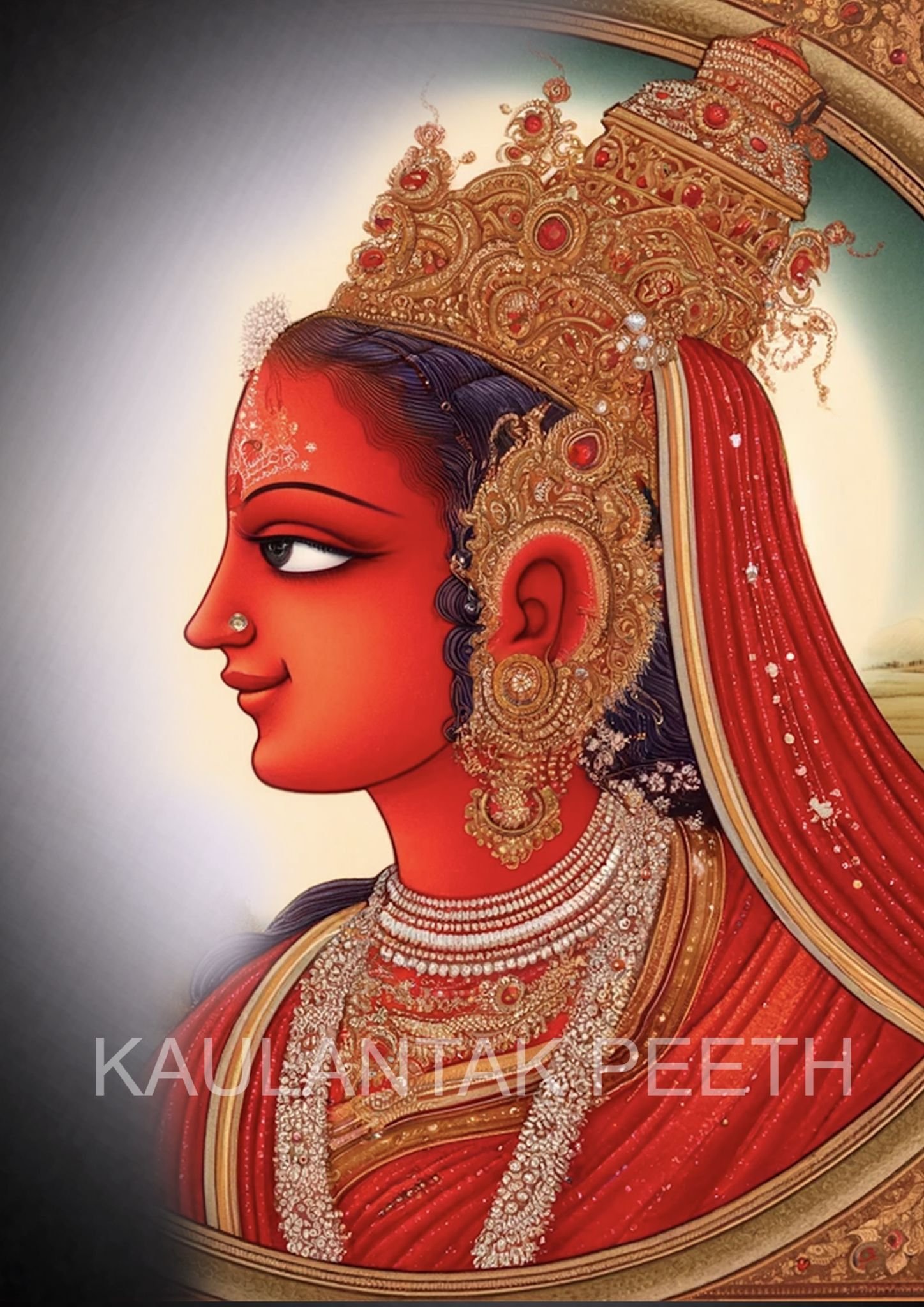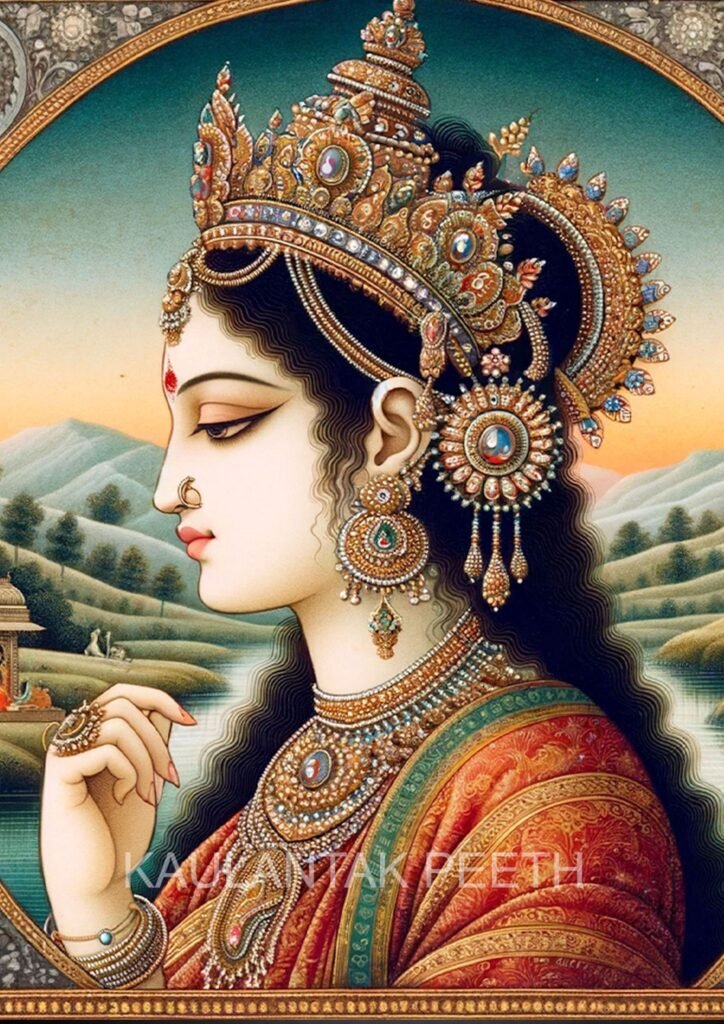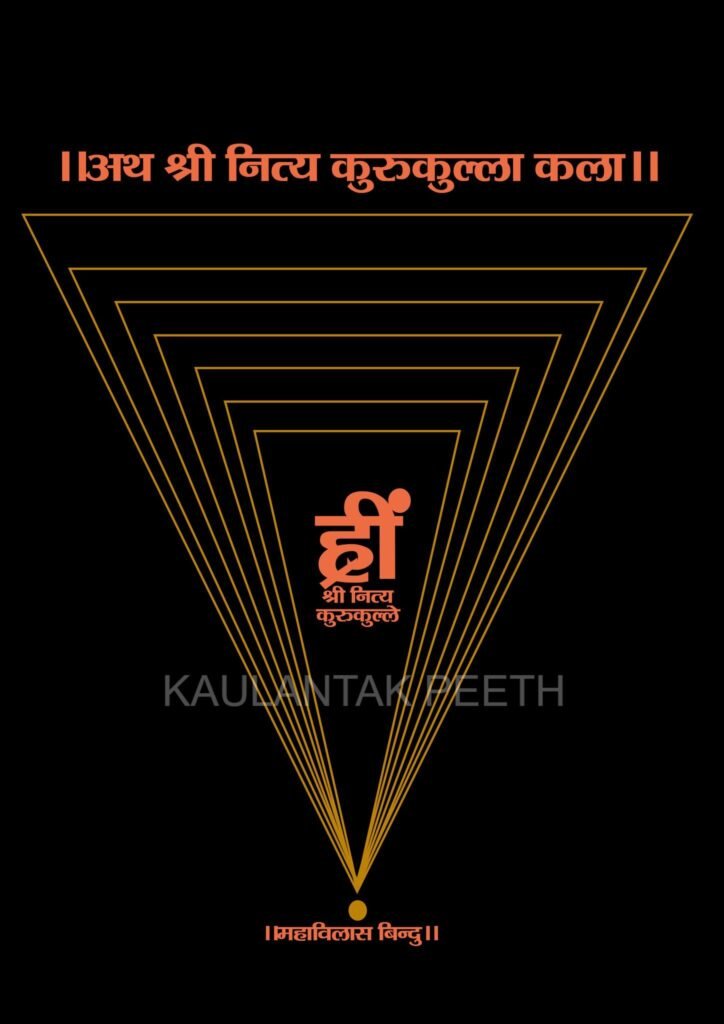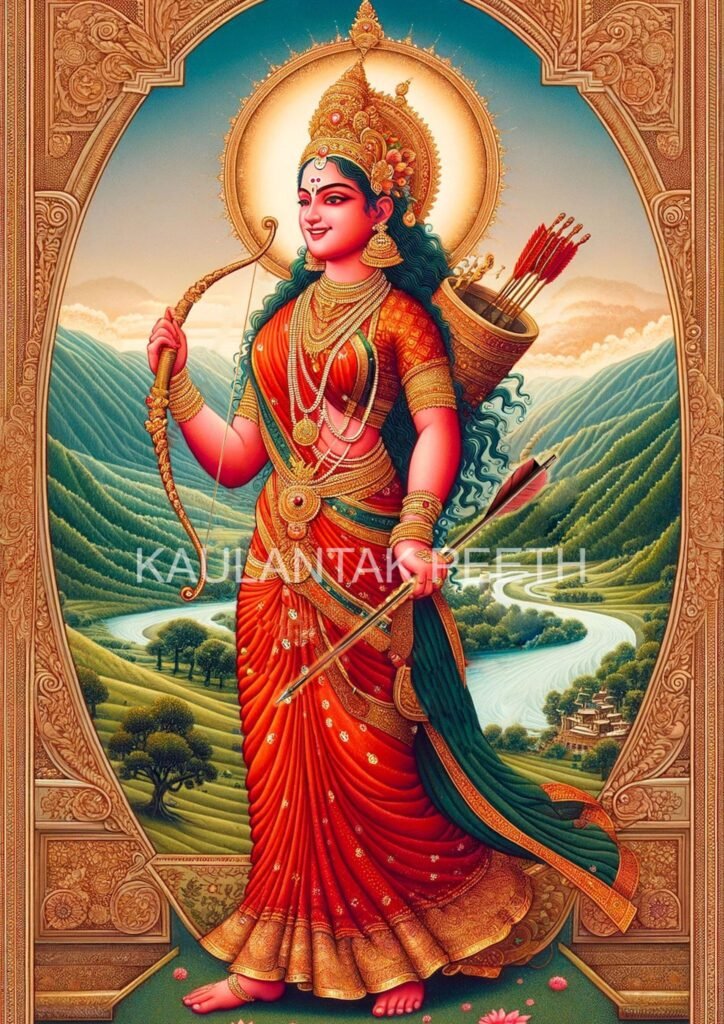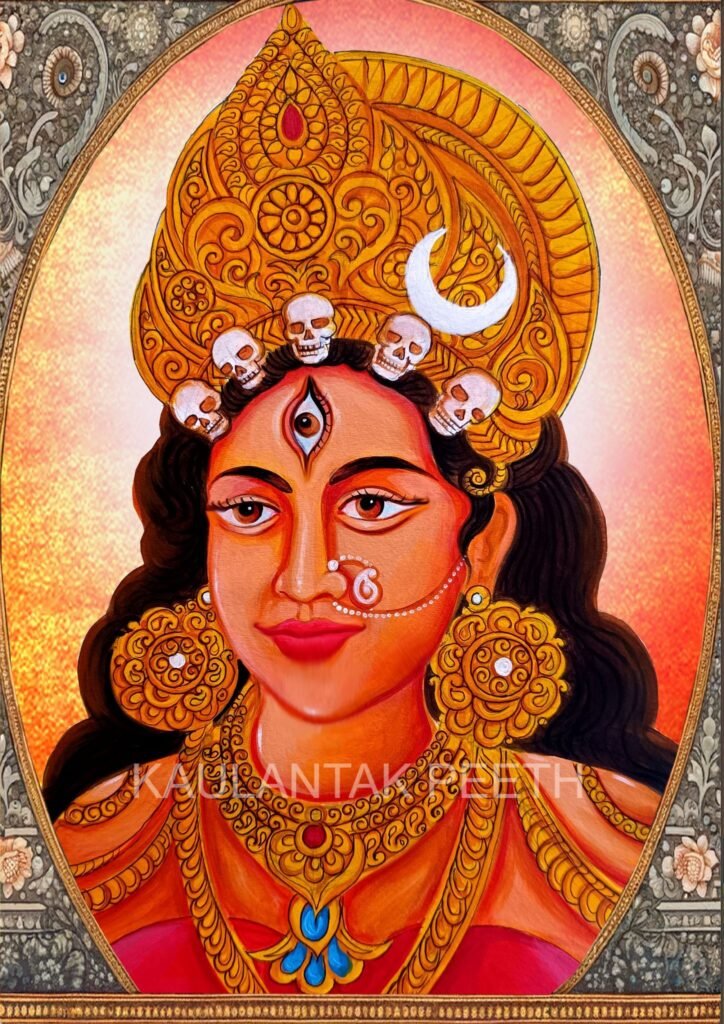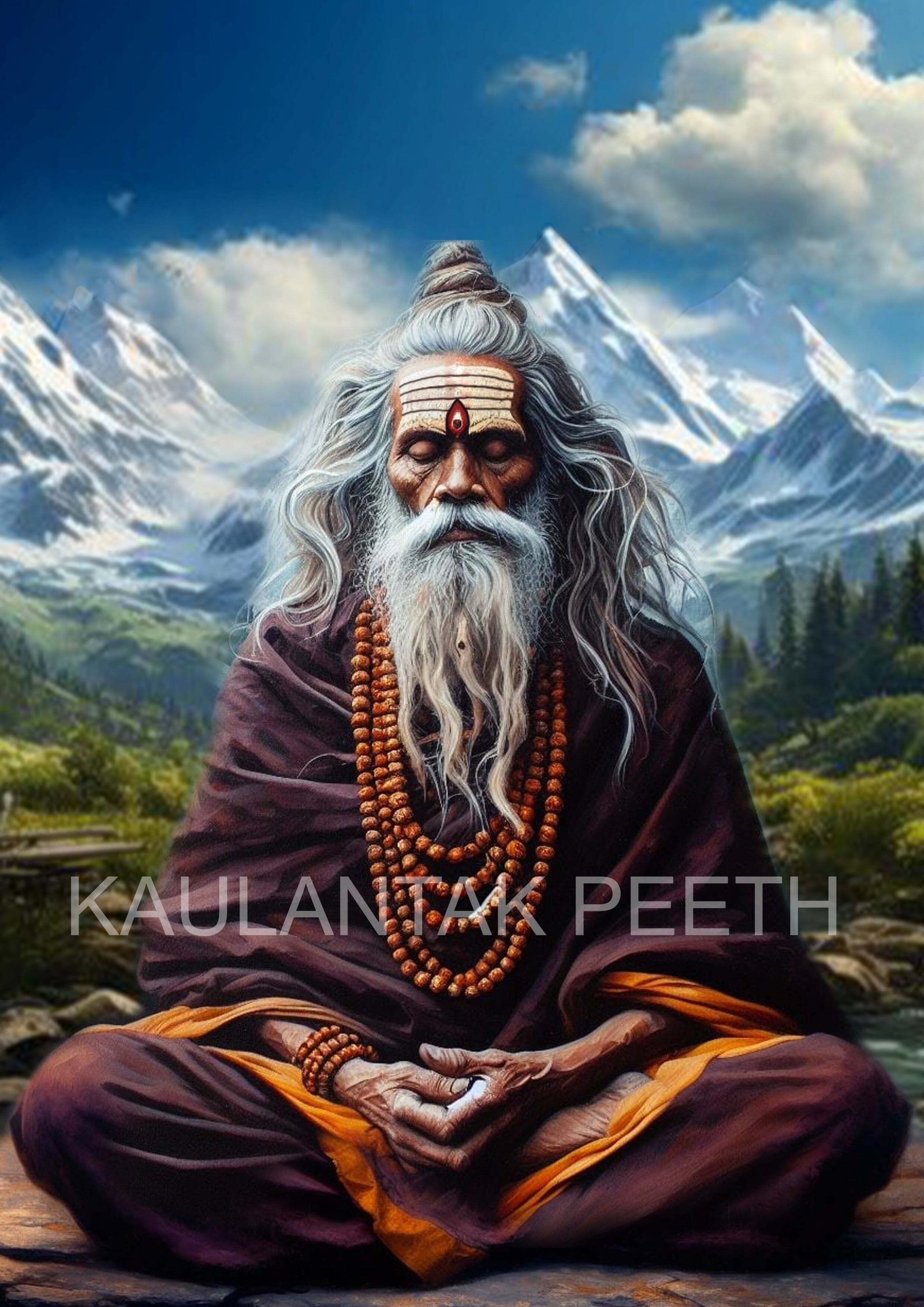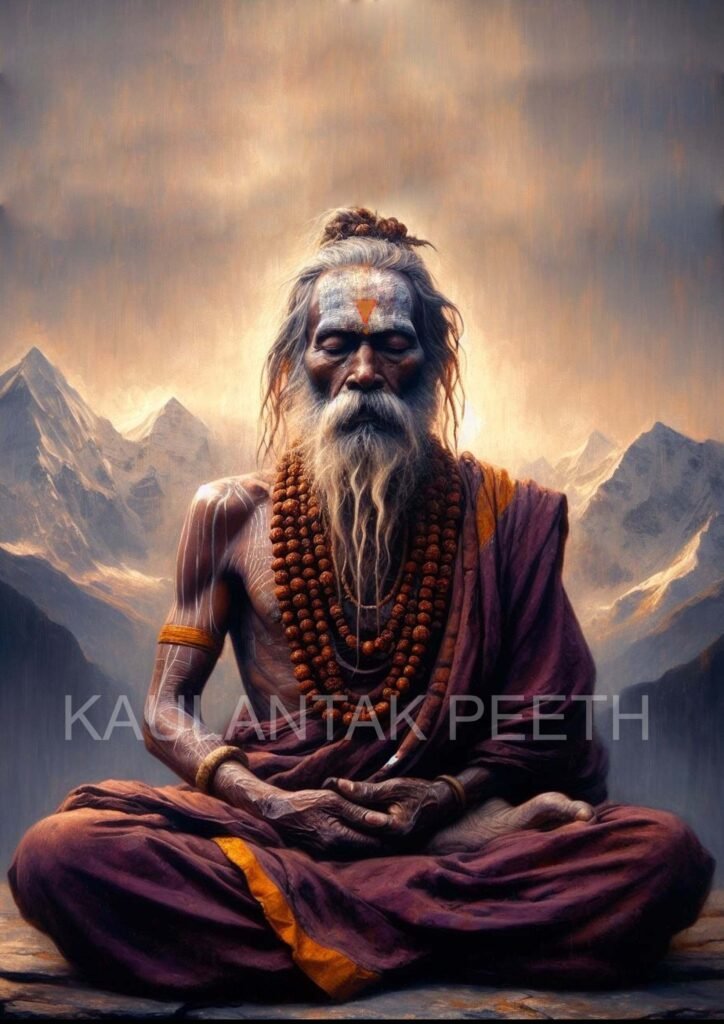Etymology and Meaning in Siddha Dharma
Nitya Kurukullā (Sanskrit: नित्य कुरुकुल्ला) is a remarkable manifesation of Goddess Kurukullā. Nitya means eternal or everlasting. Kuru (कुरु) which means one who does or is the doer or creates and destroys & Kulla (कुल्ला) meaning traditions or knowledge system.
Kurukulla is the Goddess who creates traditions or manifests the expressions and activities of the traditions. Kurukulla is the Goddess of Dakinis. Kurukulla is often called the supreme Dakini goddess.Most of tantra practices of Kurukulla and her scriptures have always been shrouded in mystery and kept hidden by Siddhas. Kurukulla is also considered as tribal Goddess.
Nitya implies something that exists every day and every moment. Something that is present today and will remain present tomorrow. There are many forms of Shakti. There are maha vidyas along with nitya shakti and there are anitya shakti as well.
Nitya Kurukullā is the most gentle form of Goddess Kurukulla whose worship ritual is straightforward, easily accessible and most effective. This is the reason from lay person to great maha siddhās, all adore and engage in the practices of Goddess Nitya Kurukullā.
Nitya Kurukulla is the form of the Goddess who always bestwos something new ever moment. Goddess Kurukulla as the Goddess of nourishments and wealth. She is the Goddess of attraction and hypnotic qualities as well. Goddess Kurukulla is also the Goddess of mystical and hidden knowledge.
Maha Siddhas say that Bhagwati Nitya Kurukulla is without body and form. She is Luminosity herself. She is tejarupini. She is a mandala of light. She is extremely subtle and supremely vast. There is nothing other than her and all the forms one sees is just her reflection. She can manifest body whenever she wants to. And she is present always in the formless form. Inside the mind, Nitya Kurukulla manifest as utkristha granthi.
Siddhas are especially fond of Bhagwati Kurukulla since she has the capacity to give everything one may desire. Nitya Kurukulla is the wisdom or Goddess or the flow of energy that gives continuously to you based on time, place and circumstances. Knowledge, power, penance, wisdom, whatever one needs in the present moment- she provides. She gives everything but does not allow one to wander off and get lost in the world.
According to Maha Siddha Ishaputra , Nitya Kurukulla takes you towards brahma bhaav. She protects you from suffering all the time. She inspires you to move forward in life and let bygones be bygones.
In kaliyuga all sadhana practices are difficult. In these challenging times, Bhagawati Kurukulla reveals herself in a form that is simple and easy for people to approach. In kaliyuga, dhyan, tap and sadhana are difficult since the mind is distracted. And on top of it, the environment around is not suitable for sadhana. People are suffering from selfishness and always looking for their selfish interests in every pursuit. In these circumstances, we constantly desire something for ourselves. Bhagawati Kurukulla provides everything easily for her devotees and practitioners. But she gives only that much so that we don’t deviate from our path. She fulfills all desires but in a way that does not cause our downfall. Therefore one form of Goddess Kurukulla became prominent for worshiping by practitioners. This is the form of Goddess Nitya Kurukulla who is everlasting and has existed before existence and will exist after all is destroyed. Therefore himalayan siddhas consider Nitya Kurukulla as a very important form of the Goddess. Himalayan siddhas recommend doing sadhana of diverse forms of the Goddess and be engrossed in doing practices of her new and diverse forms all the time.
Origin
According to siddha dharma , there was a great siddha – Mahā Siddha Tamra Shringa Nath. He was a shiv devotee from his childhood days. Mahā Siddha Tamra Shringa Nath used to tie many copper shringi around his waist. Shringi is a yantra used for abhishek or anointment ritual of Lord Shiva. Because of his fondness for shiva abhishek and tying many shringi around his waist, he was called Mahā Siddha Tamra Shringa Nath. He was a poet at heart. He would compose songs and devotional poems for Lord Shiva and Parvati and would offer his bhāva and bhakti devotion through these songs and poems.
In his life many incidents happend which had great impact on him. He had seen many floods, landslide and natural calamities from his childhood days. He would become very sad seeing all these and would wonder why such natural calamities occur which destroys the beautiful nature. He would suffer equally seeing plants and animals getting diseases. Even nightfall would pain him and he would wonder the day was so nice why did the night come. He would lament the spring getting over when the autumn season would come. He would think that there should be everlasting end to these seemingly bad things in nature and life. To solve these problems of destruction, Mahā Siddha Tamra Shringa Nath thought to do sadhana to preserve the beauty in life and nature. He thought there is no point in doing sadhana of Lord Shiva for this. So he decided to do sadhana of Bhagwati Kurukulla. After many years of sadhana , in state of deep meditation, he had a vision of Goddess Kurukulla who was pleased by his penance and instructed him to go to Vyāgra Mountain – a mountain shaped like a tiger. She tells him that she will meet him there.
After a long and arduous journey Mahā Siddha Tamra Shringa Nath reached the Vyāgra mountain. He did not find anybody there. So he found a suitable place there and started doing his sadhana on that mountain. It is said that he stayed there on vyāgra mountain for one complete ayana – uttarāyana or around six months. Before uttarāyana ended, one little girl showed up on the mountain and asked Mahā Siddha Tamra Shringa Nath why did he come there. Then Mahā Siddha Tamra Shringa Nath told her the reason why was he there. The little girl then explained Mahā Siddha Tamra Shringa Nath that beauty and knowledge is everywhere in the universe. The flow of time which appears to be destruction is just an aspect of creation. She said to him that if he does not accept this aspect of creation then he wont be able to see the other aspect of creation as well. When one sees a barren mountain, only then one can comprehend the difference between barren and fertile or beautiful mountain.
Therefore, in life only due to sadness one is able to see happiness. Life/death, pleasure/pain, joy/suffering are two sides of the same coin. But our senses are made in such a way that they only want to remain in pleasure. They dont want suffering at all. Therefore human being naturally want to avoid pain and suffering. So like this the conversation between the little girl who came to the vyāgra mountain and Mahā Siddha Tamra Shringa Nath continued. But Mahā Siddha Tamra Shringa Nath was not convinved and he kept on arguing with the little girl. He discarded her words by even claiming that she is just a little girl and what would she know, that she has not even seen the world. Then that little girl transformed into the remarkable form of Goddess. Mahā Siddha Tamra Shringa Nath saw in the reflection of that grand form of the Goddess that even the thorny bushes and the stones appeared beautiful. The barren land and desert that the Goddess showed him appeared beautiful. He even saw beauty in the movement of time that caused great cosmic destruction. It appeared that in the enchanted presence of the Goddess, Mahā Siddha Tamra Shringa Nath started seeing beauty in all the destruction that he earlied lamented about.
All his judgement about death, disease and destruction vanished. In the grand manifestation of the Goddess, Mahā Siddha Tamra Shringa Nath saw infinite universe of wisdom behind the remarkable form of the Goddess. The waves arising from that universe revealed the most supreme knowledge and shakti that followed the Goddess. He realized that there is nothing beyond the Goddess. He saw that few drops of wisdom nectar trailing off the ever rising waves and nourishing diverse species, which appeared humble and wise in the shower of grace and wisdom. In this grand revelation of Goddess, Mahā Siddha Tamra Shringa Nath heard Goddess tell him that she is giving him wisdom and a boon that he will be able to see her everlasting form amidst all the temporal and ever changing nature. Goddess then told Mahā Siddha Tamra Shringa Nath that with this wisdom his dualistic mind will dissolve and will give in to supreme intellect.
Mahā Siddha Tamra Shringa Nath went on to establish this philosophy and tradition where he knew this revealed form of Goddess as Nitya Kurukulla.
Iconography & Forms
When bhagawati realizes her true form, then Shiva asks Goddess to create traditions or kula. Goddess Yogamaya like the overflowing infinite wisdom of the ocean, created many diverse kula traditions from her three forms. This is the reason, Devi became famous as Kurukulla. Out of all the forms of Kurukulla, Nitya kurkulla is one remarkable one. Nitya Kurukulla is the Goddess whose knowledge, whose shakti is forever present.
In Siddha dharma , as per Mahā Siddha Tamra Shringa Nath Nitya Kurukulla is revealed to be standing on divine lotus holding a bow made of flowers. In one hand she is holding Kulānkusha and the other hand is in vara mudra. Swacchanda Bhairav is lying at her feet. Near her right feet, Dhanapati Kubera is sitting on lotus adored with royal jewellery and embelishments. Behind her are the 64 yogini mandala atop divine lotuses.
The vāhan or vehicle of Devi Nitya Kurukulla is western tragopan or jujurana bird. Her attire is rajasic or royal form with embelishments. All gods and Goddesses are worshiping Devi Nitya Kurukulla.
Mahā Siddha Tamra Shringa Nath praises the vyagra mountain and himalaya and says that all siddhas, Devi, Devta and Rishis worship this Goddess.
Nitya Kurukullā Kalā Trikoṇa
When Mahā Siddha Tamra Shringa Nath returned from the vyāgra mountain, then he was praised by other siddhas in himalaya request who requested him to teach his acquired wisdom in a conscise manner. Then Mahā Siddha Tamra Shringa Nath creates set of seven downward facing triangles with their tips meeting at a point. These seven triangles are proportionately placed. There is bindu or dot at the top of the tip. This is called Nitya Kurukullā kalā yantra or Kalā Trikoṇa.
This vidya of nitya kurukullā or her kalā is hidden in this yantra. There are seven steps or triangels in this yantra .
All the kalā and mysterious knowledge of Goddess Nitya Kurukullā is hidden in this yantra. There is also a symbol associated with each of the triangle.
| SL No. | Triangle | Symbol |
|---|---|---|
| 1 | Kaula Kula Cakra | Rabbit |
| 2 | Gyāna Kula Cakra | Crow |
| 3 | Tapaḥ Kula Cakra | Garuḍa |
| 4 | Shakti Pravāha Kula Cakra | Royal Swan |
| 5 | Nirguṇa Kula Cakra | Yogi |
| 6 | Shunya Kula Cakra | Devi |
| 7 | Nitya Kalā kula Cakra | Devi |
The bindu is known as mahā vilāsa bindu. Swacchanda Bhairav is the symbol.
Nitya Kurukullā Cintāmaṇī
The tradition of Nitya Kurukullā and Kalā Trikoṇa continued as oral tradition after Mahā Siddha Tamra Shringa Nath. When Maha Siddha Kosher Nath ji came, he compiled this wisdom tradition in a more uniform way. This compilation at his time was not necessarily written down but still continued as oral tradition but in a more structured manner. Eventually this oral tradition took the shape of a manuscript. This manuscript contains ten chapters.
- Nitya Stuti
- Nitya Prākaṭya
- Nitya Āvāhana
- Nitya Mantra Mālā
- Nitya Trikoṇa Kalā
- Nitya Guru Maṇḍala
- Mantra Mahā Mudrā
- Nitya Mahā Maṇḍala
- Nitya Kurukulllā Āvaraṇa
- Nitya Shanti Maṇḍala
Nitya Guru Maṇḍala
There are nine maha siddhās who are responsible for compiling the tradition in Nitya Kurukullā Cintāmaṇī. They are
- Mahā Siddha Tāmra Shringa Nātha Jī
- Mahā Siddha Koshira Nātha Jī
- Mahā Siddha Kāla Vyāla Nātha Jī
- Mahā Siddha Candra Dhara Nātha Jī
- Mahā Siddha Kula Vajra Nātha Jī
- Mahā Siddha Gyāna Medha Nātha Jī
- Mahā Siddhā Suruci Nātha Jī
- Mahā Siddhā Nāga Putrī Nātha Jī
- Mahā Siddhā Deva Ratnā Nātha Jī
Before one does upāsana ritual or sadhana Nitya Kurukullā kalā trikoṇa , or when one does sadhana or āvaraṇa pujā ritual of Nitya Kurukullā, then first one needs to do meditate upon these nine mahā siddhās along with Kaulantak Nath. One should do ritual offerings and puja of Nitya Guru Maṇḍala and Kaualantak Nath before appraoching the rituals and sadhana of Nitya Kurukullā. All the knowledge and wisdom are locked or inactive. Only by doing the rituals and seeking permission from nitya guru maṇḍala and Kaulantak Nath, one may approach this sadhana practice.
Kurukullā Temple
Kurukullā temple lies in the jogini dhār mountain in kullu district of himachal pradesh, India. One can go to this temple by taking the banjar tirthan valley road from Kullu. By stopping at Balichowki before banjar, one needs to take the link road towards Kurukullā temple. People from all over the world visit this temple to have darshan of Goddess Kurukullā.
In this temple, there are three shrines of Goddess Kurukulla in the temple along with shrine for Swacchanda Bhairav. There are ratha of Goddess Kurukulla and Svacchanda bhairava also present in the temple along with other venerated mukha and murti for pratikopasana or symbolic rituals.

